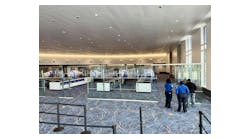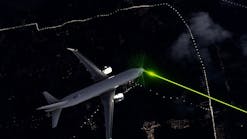An American man was traveling from Chicago to Israel for a six-day tour. He flew on a U.S. carrier. This is important to note because fliers on Israel's national airline, El Al, are always questioned about their plans before boarding the plane to Israel. Few, if any, such questions are asked by a U.S. carrier.
Upon arriving at Tel Aviv’s Ben Gurion International Airport, considered one of the world's most secure airports, the American traveler was directed to the passenger arrival customs area of the airport. His baggage and belongings traveled through typical airport security systems. However, when he met with the customs agent, along with being asked for his passport, he was asked questions such as:
• How was your trip?
• What are your plans in Israel?
• Are you traveling with a group?
• What is the name of the travel group?
• Do you know anyone living in Israel?
• Have you been here before?
• Where are you staying in Tel Aviv?
• Where are you going after you visit Israel?
The questions, including small talk about the weather and happenings in Chicago, seemed so general, bordering on the ridiculous, that the man wondered if he was being singled out.
Well, he should not have taken them personally. The reason is that in most areas of the world, when people enter a country, the airport security emphasis is on what they bring into the country. However, in Israel, the emphasis is not on the luggage but the traveler.
Trained security staff are studying the passenger’s behavior. They are listening to their comments and how they converse with the agent. If the agent determines they are acting oddly or their conversation has loopholes or discrepancies, they take these as warning signs. For instance, if the agent asks how the Chicago Cubs are playing this year and the traveler's face goes blank, that could be interpreted as a warning sign.
Customs agents do everything the X-ray machines and screening technologies can’t do. They get to know the visitor and determine if they pose a security risk.
Some Israelis report they are even more scrutinized than visitors from other countries. One Israeli tour guide decided to test the system. Arriving in Israel from Germany, he went through the typical arrival procedures like travelers from another country. However, his luggage was opened and examined twice. No reason was given.
The next time he returned to Israel from Germany, he brought no bags and no carry-on luggage. This time, he was sent to an interrogation room where he was questioned for over 45 minutes.
Having no luggage, apparently, is viewed as more of a security threat than carrying luggage, Israeli or not. Because Israel focuses on the traveler and not the baggage, it's understandable why the tour guide was questioned and became a cause for concern. (See Sidebar: What Israelis Think of Profiling)
What we are talking about is profiling. In North America and most of Western Europe, profiling is frowned upon, if not legally forbidden. However, profiling has made Ben Gurion Airport one of the safest airports in the world.
While it cannot be denied that U.S. airports are much safer today than they were years ago, according to Marc Grynberg, writing in this publication in November 2019, "the sheer volume of what goes on in an airport requires nothing short of a robust set of supervisory tools and powerful oversight to see at a glance" if airport security is working.
Although it has been debated often, because of the increased uncertainty in our world, it may be time to give profiling another look. This discussion would likely involve the Federal Aviation Administration (FAA), the Transportation Security Administration (TSA), as well as airport administrators.
The point being, and what my firm has witnessed over the past 20-plus years, is that profiling remains a hot topic that many airport administrators would like to re-consider.
The History of Profiling in the U.S.
Profiling has a long history in the United States. In the 1960s and 1970s, the U.S. witnessed a wave of hijackings. At one point, another passenger plane was hijacked every five days. Concerns mounted when a passenger was boarding with a one-way ticket. According to one airport employee, during the "hippie era," males with long hair and one-way tickets were considered immediately suspect.
Because metal detectors were not used in the 1960s, airports and airport administrators used profiling procedures and found them to be one of their best options to determine if someone was a threat. And just like in Israel, they based this determination on passenger behavior. It was accepted, and profiling was viewed as needed and justified.
However, by the 2000s, airport administrators, along with the FAA, and later the Department of Homeland Security, faced growing criticism that profiling was unethical, illegal, violated American freedoms, and at the very least, needed more regulation and oversight.
"The notion that the government is in any position to judge who is trusted and risky is very problematic," said Jay Stanley, a senior policy analyst at the American Civil Liberties Union. "Any attempt to predict who is likely to engage in that type of thing [referring to criminal or terrorist behavior in an airport] is inevitably going to sweep up a vast number of innocent people."
To address these concerns, profiling was limited or eliminated. And if it were to continue, airport administrators and TSA would have to detail screen everyone using their facilities. The problems are that we would need more human resources to do this, the costs would be tremendous, and the sheer number of people that would have to be profiled would result in mistakes – allowing potentially dangerous people to board a plane.
Still, security remains a top-priority problem for airports and a growing one at that. What are referred to as Improvised Explosive Devices, for instance, are making it harder and harder to detect if someone boarding a plane is carrying a weapon or could potentially turn an airplane into a weapon. Because of this, profiling, in one form or another, may need to be considered.
Security and Risk Assessments
In some ways, we are inching toward different forms of profiling already. Airports around the world are collecting data on passengers, developing ways to screen out those who could potentially cause harm. However, many airport administrators want to take a more proactive approach to ensure airport safety now. To accomplish this, airport administrators are having physical security and risk assessments conducted.
In general, a physical security assessment would include such things as:
● Analyzing ingress and egress points at the airport.
● Examining all current security measures in place and determining if more effective technologies are needed.
● Interviewing key security personnel to determine if they have the security training needed in an airport environment.
● Observing the exterior of the facility and determining if there are vulnerabilities that need to be addressed.
Most airport administrators are already aware of what a physical security assessment involves. However, they might not know that a risk assessment goes several steps further. It is a process, which, once again in general, includes such things as:
Setting goals and objectives. What are the strategic objectives of the risk assessment? Prevent, lessen, or mitigate potential violence in the airport?
Mitigating known risks. Risk assessment professionals invariably view any risk in an airport as a serious risk. Because of this, administrators and their staff are taught how to handle and lessen dangers should they arise.
Evaluating likelihoods and prioritizing. How likely is a hazard to occur and if it does, is it likely to result in harm? A risk assessment firm evaluates all risk likelihoods, helping airport administrators set priorities.
In other words, a risk assessment addresses the likelihood of something unfortunate happening. As discussed, it is much more involved than a physical security assessment. And one more thing – it’s crucial in today’s world. These security assessments and risk assessments should be conducted annually.
Johnathan Tal is the Chief Executive Officer of TAL Global Corporation, an international investigative and risk-consulting firm. He served as a military field intelligence officer for the Israeli armed forces during the 1970s. Tal has also served as an antiterrorism security specialist. He is a licensed investigator, Certified Private Investigator (CPI), and Certified Fraud Examiner (CFE) and holds a Bachelor of Science degree. He can be reached through his company website at www.talglobal.com.




